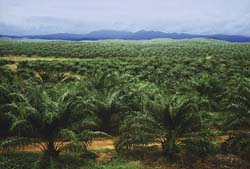crop
The project aims to determine the potential risks associated with climate change for key wheat pathogens; wheat using stripe rust, crown rot and Barley yellow dwarf virus and its aphid vector. The research approach is three-fold:
- Modelling the effects of increasing temperature on the biology and distribution of pests and diseases and vectors e.g. the bird cherry oat aphid, Rhopalosiphum padi
- Collecting real-time data on host-pathogen/pest interactions from field experiments using wheat grown under elevated CO2, and
- Developing adaptation plans for government and industry based on the above data to mitigate any increased risks posed by climate change to biosecurity of wheat crops.
What is the biosecurity problem?
Climate change is clearly recognised as a major threat to agricultural systems. The expected increase in temperature, atmospheric CO2, heavy and unseasonal rains, increased humidity, drought and cyclones, are likely to affect crops, pests and diseases and host pathogen interactions. However, the extent to which climate change will affect emergency pests and pathogens and their hosts is not clearly understood. A review of the impacts of climate change on plant biosecurity (Aurambout et al. 2006) indicated a need to document pest and disease responses to climate change and incorporate them into our management and contingency planning. To respond to future climates, changes to industry practices and government policies may be required. This project will identify the potential risks associated with climate change and plant biosecurity. Adaptation plans will be developed around these risks to inform industry practice and policy.
The main outputs of this project are to:
- provide new knowledge on the effects of elevated atmospheric CO2 on key wheat diseases, and
- develop a series of tools to inform industry and government to enhance our contingency planning to include the influence of climate change on biosecurity
Who will be the end-users of this research?
- Biosecurity policy and decision makers e.g. BA, OCCPO, PHA, state biosecurity agencies,
- PHA - data and tools will enhance threat categorisation and industry biosecurity plans
- OCCPO - data and tools may be used in incursion responses
- Industry - to adjust management strategies and biosecurity plans and increase their level of preparedness for climate change

This is a screenshot output from the Asian citrus psyllid - citrus growth model using the IPPC A1Fi climate change scenario with a Google Earth application. The ground overlay represents daily spatial variation in the population of adult psyllids displayed sequentially in an animation of 365 frames for the year 1990. The graphics depict temporal variations in the population of the Asian citrus psyllid and increasing temperature for the years 1990, 2030 and 2070 for a specific location. A total of 11,330 graphics can be accessed in the interface (one graph for each 50 km, two-grid cell on which the model was run) providing Australian coverage can be accessed in the interface (one graph for each 50km two-grid cell on which the model was run) providing Australian coverage.
The CRCNPB would like to thank Asia-Pacific Network for Global Change Research for their contribution to this project.
PROJECT LEADER

Dr Jo Luck
Project Leader CRC10071: Climate Change
Jo.Luck@dpi.vic.gov.au
Phone: 03 9210 9222
Fax: 03 9800 3521
Read More
PROJECT DETAILS
Active
Term
July 2007 - June 2010
Budget
$2,108,201 (cash and in-kind support)
PROGRAM DETAILS
LOCATION
CORE CRC PARTICIPANTS
CONTRIBUTORS
INDUSTRY RELATED
From the arm of the chair
 A picture of oil palm in Malaysia may seem a strange way to start notes on some CRC for Plant Biosecurity happenings but, read on.
A picture of oil palm in Malaysia may seem a strange way to start notes on some CRC for Plant Biosecurity happenings but, read on.
This project developed an understanding of how biotic factors affect the dispersal of rain-splashed asexual spores (conidia) and wind-borne sexual spores (ascospores).
What is the biosecurity problem?
Once an exotic fungal pest has been introduced to a new area (such as via seed or soil) establishment and further spread are influenced largely by the spore dispersal pattern. Long-distance dispersal via wind-borne spores is a common feature of fungal pests, as is short-distance dispersal via rain-splash of spores. Studies that identify the link between environmental factors and spore dispersal can assist in assessing the potential disease risk for agrogeographical zones. Ascochyta species of pulse crops are already within Australia and have rain-splashed asexual spores (conidia) and wind-borne sexual spores (ascospores). These fungi provide an opportunity to study the relationship between the environment and spore dispersal, and to develop risk assessment strategies for exotic pests with similar spore dispersal patterns.
The main outputs of this project were to:
- identify key factors influencing the short-distance (rain-splashed) and long-distance (wind-borne) distribution of spores of exotic foliar pests of annual field crops, using Ascochyta blight as a model.
- determine effect of rainfall, temperature, wind, landscape and host susceptibility on spread of conidia and disease from artificially-inoculated plants placed in crop
- Use controlled conditions to determine the effect of rain and wind on spore dispersal for pests that spread via rain-splash or wind, and
- identify potential disease risk for different agroecological zones.
Who will be the end-users of this research?
This project produced a new PhD graduate trained in Plant Pathology, with specific skills in plant disease epidemiology. The graduate was available for immediate employment within the Biosecurity industry, increasing Australia's capability to respond to disease outbreaks
STUDENT

Mr Steven Coventry
Student CRC60003: Ascochyta Wind Tunnel - PhD
steven.coventry@adelaide.edu.au
Phone: 08 8303 7259
Fax: 08 8303 7109
Read More
PROJECT DETAILS
Complete
Supervisor
Dr Eileen Scott (UOA) and Dr Jenny Davidson (SARDI)
Supervising Institution
La Trobe University
Term
March 2006 - March 2009






